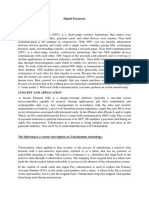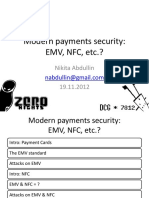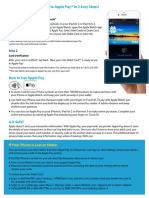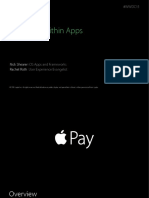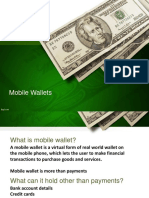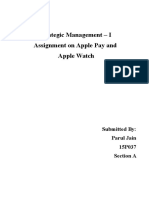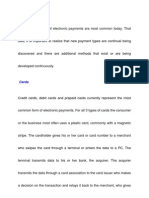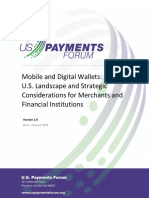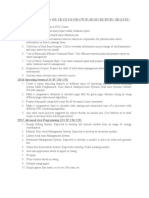Apple Pay & Digital Payments
Brock Blahous, Gabby Harness, Jack Heffernan, Tristan McDevitt, Poun Phongprasansak
I S 410 Group 4
Mingwen Yang
May 27,2021
� Company
Apple Computer Company, presently known as Apple Inc, was founded on April
1, 1976 by Steve Wozniak and Steve Jobs in the Bay Area, California. The company’s
first product was Apple I, an early personal computer. Apple was incorporated on
January 3, 1977 and over the next five years they would experience an annual average
growth rate of 533 percent.
In 1983, Apple released the first computer produced without a programming
language, the Macintosh. Although the Macintosh was initially successful, many PC
clones of the late-1980s were much less expensive and caused Apple to lose their
monopoly in the personal computer market. The company witnessed successes and
failures with various products launched between this time and the 1990s when Apple
began producing the iMac, a computer sold to this day, with frequent updates of course.
2007 led to major changes for Apple just following the 2006 release of the
Macbook Pro, one of the most popular laptop computers to date. Steve Jobs announced
that the emphasis of Apple would change from computers to consumer electronics,
what we know today as the iPad, iPod, iPhone, etc. Hence, the name changed from
Apple Computer to just Apple Inc. In July of 2008, the Apple App Store was introduced,
a market for third-party applications to be purchased on the iPhone and iPod Touch.
The iPhone 4, the first iPhone to have a camera and video-calling capabilities
was released in 2010 along with the original iPad, AppleTV, and Facetime. In 2011,
Steve Jobs left Apple Inc to focus on his health and unfortunately died later that year.
Prior to his passing, Jobs released the final Apple product of his lifetime, iCloud, a
content syncing service for files including music, media, and text. All Apple users are
given a base amount of iCloud storage for free and storage can be increased with
monthly payments.
After the death of Steve Jobs, Tim Cook became the CEO of Apple Inc. Over the
years, Apple has redesigned aforementioned products to fit today’s market and has
introduced new operating systems, softwares, and smart products to compete with large
players such as Samsung, Microsoft, and Amazon. Computers currently sold by Apple
are the iMac, Macbook Air, and Macbook Pro. External computer servers include the
Mac Pro and Mac Mini. There are four different iPads, all compatible with the Apple
Pencil, a stylus tool. The iPhone is on its 12th generation, equipped with ioS 14, four
cameras, and offered in six colors. Apple makes a variety of other products including
headphones, earbuds, watches, TV services, credit cards, speakers, and more. The
Apple Card is conveniently attached to Apple Wallet, allowing users to conveniently pay
with Apple Pay, right with the tap of their iPhone.
Product
Apple Pay is a contactless payment and digital wallet service introduced on
Apple devices in 2014. Using Near Field Communication (NFC), Apple Pay users can
1
�pay in (participating) stores and when making in-app or online purchases. Digital
payment services are a growing industry and Apple Pay is a simple way for existing
Apple device users to conduct contactless payments without the use of a physical card.
To use Apple Pay, users must upload their card information into the Apple Wallet
application. This app is preinstalled on all Apple products made after 2014 and users
are even prompted to set up Apple Wallet and Apple Pay upon initial device setup.
Devices that use Apple Pay include the iPhone (with touch ID or face ID excluding the
iPhone 5s), iPad, Apple Watch, and Mac (with touch ID).
Apple has recently created the Apple Card, a credit card which users may store in Apple
Wallet along with any other cards they chose to upload to use with Apple Pay. The Apple Card
is extremely secure and charges less interest than a typical credit card. When Apple Pay is
used to complete a transaction, it tokenizes your card information and transfers a device
account number to the cashier or online interface’s system. Thus, store’s never directly receive
card information, making Apple Pay transactions very sealed and safe when compared to
traditional modes of purchasing.
How It Works
There are four different ways to use Apple Pay: iPhone or Apple Watch to
terminal, in-app purchases, pay on the web using Safari, and sending money through
Messages. Using an iPhone or Apple Watch to pay is the only physical method of
payment. In-app purchases, paying on the web, and sending money through Messages
are all done virtually.
Any iPhone (6th generation and newer) and all Apple Watch generations have
Near Field Communication (NFC) technology embedded into the hardware. This
technology allows for the communication of the payment between the point-of-sale
(POS) terminals and the user’s device. The POS terminal must have NFC technology
embedded as well. Users who use this process first select the method of payment of
their choice (Credit/Debit Cards, Gift Cards, Apple Cash, etc.). Then, the user must
authorize the use of a method of payment by either scanning their face (FaceID) or
fingerprint (TouchID). Once a method of payment is authorized, the user must put their
device near the POS terminal for the transaction to be processed. Data of the
transaction is then protected by Secure Element - a host application for Apple Pay.
During the transaction, the POS terminal communicates directly with the Secure
Element application through the NFC controller. This allows for payment security as only
the payment network or card issuer has access to the encryption of the payment and is
not exposed to an Application Processor.
In-app purchases and purchases on the web using Safari can be done on
iPhones, iPads, and Macs through apps purchased on Apple’s App Store. Once the
user is ready for check out, payment is only processed once there is a chosen payment
method and authorization of the user using FaceID or TouchID. For purchase on the
web, there will be a prompt on the device asking if the user would like to use Apple Pay.
2
�This payment is then encrypted using Secure Element to the Apple Pay server.
Afterwards, payment authorization details are routed to the Application Processor.
For sending money through Messages, both the sender and receiver must have
an Apple account and an Apple device. Users would first open their Messages
application, then select the Apple Pay option. Once the Apple Pay option is selected,
users will be prompted to choose the amount of money and whether they are requesting
or sending money from another user. If the user is sending money, they will be able to
choose the payment method that is stored on their Apple Wallet. Authentication through
FaceID or TouchID is then required to complete the transaction. The receiver will then
have that money stored on their Apple Cash card - a virtual card that stores a certain
amount of value only on Apple devices. The Apple Cash card can be used in any of the
listed ways of using Apple Pay.
Risks
Apple Pay is Apple's mobile payment system which utilizes NFC technology as
an alternative to cash and card payments. Though this technology has had its fair share
of security threats and risks, it's important to point out that in many ways, it's more
secure than using physical forms of payment like a credit card or cash. Apple Pay does
not share any credit card information when processing a payment so traditional hacks,
such as a card skimming device which gathers information from swiping the magnetic
strip on a card, are not possible. Each transaction uses a one-time code that processes
payment without using any credit card numbers or information. That way, any abuse of
this one-time transaction code can only be used on one occasion rather than repeated
like a criminal could do with a credit card number. The digital wallet is also linked
through an apple ID and verified each use through biometrics, passwords, and pins.
Even if an icloud account was hacked and a digital wallet was put into the hands of a
criminal, no transactions would go through without these secondary forms of
identification. While Apple Pay is one of the most secure forms of payments, it has had
its fair share of issues and risks.
One of the largest issues with Apple Pay is that it still relies on the input of credit
card information. Between 2015 and 2016, a Miami resident had spent $1.5 million
using stolen credit card information and loading it into an Apple Pay digital wallet. The
criminal was able to make purchases in-store with no additional identification. Although
Apple Pay was not necessarily the party at fault, its technology is easily abused when
criminals get ahold of credit card information. To fix this issue, some banks have begun
requiring verification via text, call or mobile app when inputting a new card into an Apple
Pay wallet. Although this does not allow anyone but the card owner to add a card to the
wallet, not all banks require this verification.
Another hack on Apple Pay is through the use of public or fake wifi hotspots that
requires users to make a profile. Once connected, hackers can steal the Apple Pay
3
�cryptogram which is the key to encrypting the one-time transaction code. While most
cryptograms are used once, merchants often allow these “one-time” codes to be used
multiple times.
The risks associated with Apple Pay are due to shortcomings in traditional forms
of payments such as credit cards. Without biometric and password authentication,
hacking Apple Pay is quite difficult since no banking information is actually transmitted
during a payment. Overall, Apple Pay in itself is quite a secure form of payment.
Industry Competitors
Now we will get into the industry as a whole that Apple pay resides in, as well as
the main competitors that exist alongside Apple pay. Before looking into the competitors
however, understanding Apple pay’s standing in the industry is crucial. Research
conducted by Auriemma Consulting group found that 98% of all Apple pay users were
“Very Satisfied”. Coupled with the fact that iPhones make up 49% of the US market for
cellular devices, and it is easy to see that Apple Pay is dominant in the field of mobile
payments.
Even though Apple pay is a massive contributor to the mobile payments field,
there certainly are some other platforms that are attempting to keep up. Here we will lay
out some of the main competitors that Apple pay is contending with. Keeping things
simple, we will first look at how Google pay and Samsung pay stack up. Then we will
look at venmo's role in the market.
First, let's see how Google and Samsung pay compare. Like Apple pay, Google
and Samsung pay are other virtual wallets to be used in transactions. Also similar to
Apple pay, you will need a device capable of running either Google pay or Samsung pay
to enjoy the service, meaning you will need an android phone for Google and a
Samsung phone for Samsung pay. This is potentially a positive for both Google and
Samsung pay in the sense that there are many different Android or Samsung phones on
the market. However, in the United States, Apple users far outnumber users of Androids
and Samsung phones. As far as the platforms themselves, Google and Android pay are
much the same as Apple pay. All platforms can send money directly to others and can
also be used in select locations to pay in place of a physical card or cash. When it
comes down to it, you will be using whatever virtual wallet platform comes with the
phone you use. One thing to note here is the actual usage of the virtual wallets against
all users of the phones. Apple pay has the highest usage rate with 13% of Apple users
saying they had used the wallet once or more. Google pay had a usage rate of 7% and
Samsung came in at 5% (business).
Now we will see how venmo stacks up to Apple pay for peer-to-peer payments.
First we will note the areas where Apple pay has an edge. For one, getting started using
Apple pay is as simple as having an iPhone and linking your phone to any current
payment option you have, i.e. a credit or debit card. Compare this to having to download
4
�the venmo app and setting the platform up yourself. Another point to Apple comes in the
ease of switching between payment options for peer-to-peer payments. If you want to
use one card over another it is as simple as switching which card appears first in the
interface before making the payment. In venmo you must go through a somewhat
lengthy process of switching your desired payment option. Apple pay also wins for its
transfer limits. Apple pay allows you to send up to $3,000 for one transaction where
venmo limits each transaction to $2,000. One point to venmo's credit is the fact that you
can use the platform anywhere you have an internet connection using venmo.com.
Apple pay on the other hand is limited to your mobile devices. Another plus for venmo is
the fact that you can link a bank account directly to the app for payments. Apple pay
does not allow this. However, you can link a debit card to your Apple pay which is
almost the same thing. Both of these platforms do not charge for their services so there
is no winner in that regard. All in all, if you have used venmo in the past there is no real
reason to switch to Apple pay and vice versa.
Future Opportunities
The COVID-19 pandemic has changed so many elements of daily life across the
world, and many of these changes are here to stay. Some of these changes include
work-from-home opportunities, new curbside takeout options, and especially increased
support for contactless payments. Several studies from point-of-sale cashiers provided
data as evidence of this increased support for contactless/digital payments: use of
Apple Pay for in-store transactions rose by 59% in 2020 (PYMNTS), compared to
growth of 29% in overall in-store mobile payment use (Perez). This demonstrates that
Apple Pay is rising in popularity.
During 2020 across the globe, statistics from point of sale systems showed that
digital payments accounted for 10% of total spending, in comparison to 11.9% of
spending consisting of cash. This comparison demonstrates that digital payments will
soon replace cash as the second most popular payment method following traditional
credit cards.
Apple Pay is also supported as an acceptable payment method in more than
90% of stores in the United States. The requirement for stores to implement contactless
payment was the final push for many stores to convert their payment systems for
customers. A large proportion of these stores consisted of smaller mom-and-pop shops
that originally stuck to traditional cash and credit POS systems, but were encouraged to
implement new contact-free payment to create a safer environment for both customers
and employees.
In combination with the recently introduced Apple Card in August of 2019, there
is strong potential for Apple Pay to surge ahead in popularity in the coming years. Given
that the Apple Card is currently available only in the United States at the time of writing
(May 2021), there is even increased potential for growth of Apple Pay when operations
5
�are expanded to allow for Apple Card distribution in other countries. However, Apple
Pay has already demonstrated the strong user preference just in the United States as a
result of the Apple Card-Apple Pay combination system. According to a study from
eMarketer, Apple Pay currently holds 43.9 million users in the U.S., leading far ahead of
Starbucks, Google Pay, and Samsung at 31.2, 25.0, and 16.3 million users, respectively
(Perez).
Both the millennial population and Generation Z population are strong
contenders for future users of Apple Pay. Apple Pay offers spending tracking, cash-back
and loyalty benefits, and universal cashback usage which aligns very closely with the
preferences of these two generations. 52% of both millennial and Generation X users of
Apple Pay used the system in-store during the 2020 study period, which trailed behind
73.1% of Gen Z consumers in the same environment (PYMNT). As Generation Z begins
to capture more of the nation’s wealth, it is clear that Apple Pay will become
increasingly prominent in daily life.
Although Apple Pay was not the first digital wallet to be introduced, it certainly
has the strongest potential as an industry leader for the new future. Supported by
Apple’s massive market share and complemented by the Apple Card, it is clear that
Apple Pay will soon be used ubiquitously among the majority of the population using
Apple products such as the iPhone and Apple Watch.
6
� Works Cited
“Apple Inc.” Encyclopædia Britannica, Encyclopædia Britannica, Inc.,
www.britannica.com/topic/Apple-Inc.
“Apple Pay.” Apple, www.apple.com/apple-pay/.
Brewster, Thomas. “Millions Are Being Lost To Apple Pay Fraud-Will Apple Card
Come To The Rescue?” Forbes, Forbes Magazine, 6 Jan. 2021,
www.forbes.com/sites/thomasbrewster/2019/03/27/millions-are-being-lost-to
-apple-pay-fraudwill-apple-card-come-to-the-rescue/?sh=681d1a95622f.
Evans, Apple Holic By Jonny, and Jonny Evans. “Driven by Pandemic, the US
Enters the World of Apple Pay.” Computerworld, Computerworld, 25 Feb.
2021,
www.computerworld.com/article/3609452/driven-by-pandemic-the-us-enters
-the-world-of-apple-pay.html.
“Google Pay vs. Apple Pay vs. Samsung Pay.” Business.com,
www.business.com/articles/google-pay-vs-apple-pay-vs-samsung-pay/.
Hayes, Adam. “Apple Pay Definition.” Investopedia, Investopedia, 19 May 2021,
www.investopedia.com/terms/a/apple-pay.asp.
“How Apple Pay Uses the Secure Element and NFC Controller.” Apple Support,
support.apple.com/guide/security/secure-element-and-nfc-controller-seccb5
3a35f0/web.
“Is Apple Pay Safe?” U.S. News & World Report, U.S. News & World Report,
creditcards.usnews.com/articles/is-apple-pay-safe.
Laryea, Brittney, and Mandi Woodruff. “How Apple Pay Cash Stacks Up Against
Venmo.” MagnifyMoney, 19 Apr. 2021,
www.magnifymoney.com/blog/news/apple-pay-cash-vs-venmo-507617305/.
Perez, Sarah. “Fueled by Pandemic, Contactless Mobile Payments to Surpass Half
of All Smartphone Users in US by 2025.” TechCrunch, TechCrunch, 5 Apr.
2021,
techcrunch.com/2021/04/05/fueled-by-pandemic-contactless-mobile-payme
nts-to-surpass-half-of-all-smartphone-users-in-u-s-by-2025/.
PYMNTS.com. “Is The Pandemic Apple Pay's Big Opportunity?” PYMNTS.com, 20
Oct. 2020,
7
� www.pymnts.com/mobile-wallets/2020/apple-pay-sixth-birthday-mobile-wall
et-use/.
Rian Boden • 11 August 2015 • nfcw.com. “Apple Pay Gets 98% Satisfaction Rate
for in-Store Purchases • NFCW.” NFCW, 11 Aug. 2015,
www.nfcw.com/2015/08/11/337076/apple-pay-gets-98-satisfaction-rate-for-i
n-store-purchases/.
“Stock Picks, Stock Market Investing.” SeekingAlpha,
seekingalpha.com/instablog/22912651-daniel-jennings/5020087-apple-pay-
can-be-hacked.

